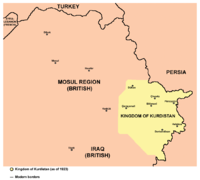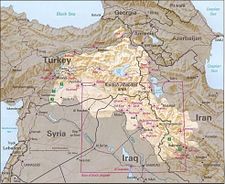تاريخ الأكراد
| جزء من سلسلة مقالات عن التاريخ والثقافة الكردية |
 |
الأكراد (بالكردية: کورد، Kurd)، وأيضاً الشعب الكردي (بالكردية: گەلی کورد، Gelê Kurd)، هم جماعة عرقية إيرانية شمالية غربية في الشرق الأوسط. تاريخياً، استوطن الأكراد المناطق الجبلية إلى الجنوب من بحرية ڤان وبحرية أورميا، منطقة جغرافية يطلق عليها كردستان. معظم الأكراد يتحدثون الكردية الشمالية (الكرمنجية) أو السورنية، وتتنمي كليهما إلى مجموعة اللغات الكردية.
يعتبر الكُرد كعرقٍ جزءًا من العرقيات الإيرانية[1][2][3][4][5][6][7]. يتواجد الأكراد - بالإضافة إلى هذه المناطق - بأعداد قليلة في جنوب غرب أرمينيا وبعض مناطق أذربيجان ولبنان. يعتبر الأكراد إحدى أكبر القوميات التي لا تملك دولة مستقلة أو كياناً سياسياً موحداً معترفاً به عالمياً. وهناك الكثير من الجدل حول الشعب الكردي ابتداءً من منشأهم، وامتداداً إلى تاريخهم، وحتى مستقبلهم السياسي. وقد ازداد هذا الجدل التاريخي حدة في السنوات الأخيرة وخاصة بعد التغيرات التي طرأت على واقع الأكراد في العراق عقب حرب الخليج الثانية، وتشكيل الولايات المتحدة لمنطقة حظر الطيران التي أدت إلى نشأة كيان إقليم كردستان في شمال العراق.
ينقسم الأكراد إلى أربعة مجموعات إيرانية الكرمانجي، والكلهود، والكوران، واللور وكل مجموعة لها لغة خاصة.
التسمية
مصطلح الاكراد تاريخيا كان يطلق على جميع البدو الرحل والقبائل البدوية في إيران على اختلاف اعراقهم ولغاتهم بيما في ذالك البلوش والفرس واللور، الذين هم جماعة الذين سكنوا تاريخيا المناطق الجبلية في جنوب القوقاز (شمال زاغروس وطوروس سلاسل الجبال الشرقية)، وهي منطقة جغرافية يشار إليها مجتمعة باسم كردستان. الأكراد يتحدثون الكورمانجية والسورانية، والتي هي اللهجات المحكية من اللغات الكردية. وهي تشكل فرع من اللغات الإيرانية الشمالية الغربية، والتي بدورها هي فرع من عائلة اللغات الهندو أوروبية.
التاريخ المبكر
الفتوحات الإسلامية
الإمارات الكردية المبكرة
الفترة الأيوبية


الإمارات الكردية بعد الفترة المغولية
الفترة الصفوية
تهجير الأكراد
مذبجة گانجا
معركة ديميم
الفترة العثمانية
ثورة الجنبلاط
المعركة ضد اليزيديين
ثورة الرزيقيين
بدر خان من بوتان
ثورة الشيخ عبيد الله والأرمن
تاريخ القرن 20
صعود القومية
بعد الحرب العالمية الأولى



الوضع الحالي
تركيا
العراق
إيران
سوريا
أرمنيا
أذربيجان
الأكراد في الأردن، سوريا، مصر ولبنان
الجينات الوراثية
التشابه مع الأوروپيين والقوقازيين
التشابه مع الأذريين الإيرانيين
التشابه مع الجورجيين
التشابه مع اليهود
انظر أيضاً
انظر أيضاً
الهوامش
المصادر
- ^ Bois, Th.; Minorsky, V.; Bois, Th.; Bois, Th.; MacKenzie, D.N.; Bois, Th. "Kurds, Kurdistan." Encyclopaedia of Islam. Edited by: P. Bearman , Th. Bianquis , C.E. Bosworth , E. van Donzel and W.P. Heinrichs. Brill, 2009. Brill Online. <http://www.brillonline.nl/subscriber/entry?entry=islam_COM-0544> Excerpt 1:"The Kurds, an Iranian people of the Near East, live at the junction of more or less laicised Turkey"
- Michael G. Morony, "Iraq After the Muslim Conquest", Gorgias Press LLC, 2005. pg 265: "Kurds were the only smaller ethnic group native to Iraq. As with the Persians, their presence along the northeastern edge of Iraq was merely an extension of their presence in Western Iran. All of the non-Persian, tribal, pastoral, Iranian groups in the foothills and the mountains of the Zagros range along the eastern fringes of Iraq were called Kurds at that time."
- ^ G. Asatrian, Prolegomena to the Study of the Kurds, Iran and the Caucasus, Vol.13, pp.1-58, 2009: "The ancient history of the Kurds, as in case of many other Iranian ethnic groups (Baluchis, etc.), can be reconstructed but in a very tentative and abstract form"
- ^ Michael G. Morony, "Iraq After the Muslim Conquest", Gorgias Press LLC, 2005. pg 265: "Kurds were only small ethnic group native to Iraq. As with the Persians, their presence along the northeastern edge of Iraq was merely an extension of their presence in Western Iran. All of the non-Persian, tribal, pastoral, Iranian groups in the foothills and the mountains of the Zagros range along the eastern fringes of Iraq were called Kurd at that time.
- ^ E. J. van Donzel, "Islamic desk reference ", BRILL, 1994. ISBN 9004097384. pg 222: "Kurds/Kurdistan: the Kurds are an Iranian people who live mainly at the junction of more or less laicised Turkey, Shi'i Iran, Arab Sunni Iraq and North Syria and the former Soviet Transcaucasia. Several dynasties, such as the Marwanids of Diyarbakir, the Ayyubids, the Shaddadis and possibly the Safawids, as well as prominent personalities, were of Kurdish origin.
- ^ John Limbert, The Origins and Appearance of the Kurds in Pre-Islamic Iran, Iranian Studies, Vol.1, No.2, Spring 1968, pp.41-51. p.41: "In these last areas, the historic road from Baghdad to Hamadan and beyond divides the Kurds from their Iranian cousins, the Lurs."
- ^ RUSSELL, JR 1990 « Pre-Christian Armenian Religion*, dans Aufstieg und Nieder- gang der Romischen Welt, II, 18.4, p. 2679-2692, Berlin-New York, 1990., pg 2691: "A study of the pre-Islamic religion of the Kurds, an Iranian people who inhabited southern parts of Armenia from ancient times to present, has yet to be written"
- ^ Discoveries from Kurdish Looms by Robert D. Biggs, Mary and Leigh Block Gallery, Northwestern University, 1983, p.9 "Ethnically the Kurds are an Iranian people"
قراءات إضافية
- Nineveh and Its Remains: A Narrative of an Expedition to Assyria 1867, Massacre of Nestorians by Bedr Khan Beg, Pages 129–174.
- John Murray (1867), Nineveh and its remains: a narrative of an expedition to Assyria during the years 1845, 1846 and 1847
وصلات خارجية
- "A Brief Survey of the History of the Kurds", by Kendal Nezan, President of the Kurdish Institute of Paris.
- Yezidism: historical roots, International Journal of Kurdish Studies, January 2005.
- The forced conversion of the Jewish community of Persia and the beginnings of the Kurds
- Encyclopaedia of Kurdistan KURDISTANICA
- History of Judaism in Kurdistan KURDISTANICA
- Kurdish Institute Kurdish language, history, books and latest news articles
- "Battle of DimDim", Encyclopædia Iranica
- "Deportations, part III. In the Islamic Period", Encyclopædia Iranica.
